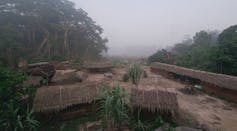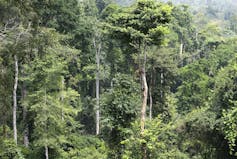Forests are great carbon sinks – they absorb more carbon from the atmosphere than they release. Globally, forests remove nearly all of the two billion tonnes of carbon dioxide that is currently being removed from the atmosphere every year.
These days, companies can buy “carbon credits” for the carbon that is stored in living forests and offset this against their own greenhouse gas emissions. International financiers estimate that by 2050, Africa could be selling US$1.5 trillion in carbon credits per year, mainly from its forests. Environmental social scientists Constance L. McDermott, Eric Mensah Kumeh and Mark Hirons are co-authors of a report on global forest governance for the International Union of Forest Research Organisations. They have found that buying and selling forest carbon as a commodity is dangerous if it is prioritised over the other environmental and social uses of forests. It could even result in environmental damage and the displacement of forest-dependent people.
What is a carbon sink?
All living things contain carbon, and are considered carbon sinks when they absorb more carbon from the atmosphere than they release. Many ecosystems serve as carbon sinks, but forests have a large biomass (wood and twigs and leaves on the forest floor). This makes them a very important sink from a climate perspective.
The carbon that trees capture is sequestered (stored) in their wood, leaves or needles, and roots. When forests are cut down or burned, their stored carbon is released into the atmosphere and becomes a source of carbon emissions rather than a sink. Forest carbon sinks can be conserved by leaving live trees standing, or created and enhanced by planting or natural regeneration of trees.
Why is it a problem for a forest to be seen only as a carbon sink?
Forests support and regulate soil, water and nutrient flows, and provide habitat for the majority of the world’s species that live on land. They provide people with food, fuel, fibre, medicine and other products.
They are important to the cultural survival and well-being of many communities. In Africa alone, an estimated 245 million people live within five kilometres of a forest, and many of these people rely directly on forests for their livelihoods.
Read more: ‘Sacred forests’ in West Africa capture carbon and keep soil healthy
Our research found that forests are increasingly being managed as carbon sinks, and the carbon they store treated as a commodity that can be internationally traded. Carbon markets allow businesses and governments to earn credits by paying for forests that reduce greenhouse gas emissions, which is cheaper than reducing their own emissions. This is part of what we call the climatisation of forests.
Governing forests only as carbon sinks can promote “green grabs” where non-forested land, such as grasslands, used by communities for farming and other activities, is taken from the community and used by wealthy companies or governments to plant large tracts of trees to store carbon. Sub-Saharan Africa, in particular, is being targeted as a readily available and inexpensive location for one million hectares of forest restoration and tree plantations.

This is especially threatening for people who do not have secure rights to the forests and land they depend on. These communities can even be restricted or banned from entering the forest. Research has found that forest-dependent communities are rarely given power to address their own priorities in forest carbon sink schemes. This can cause conflict locally and weaken local democracy.
Read more: Sharing benefits from the UN's deforestation reduction program remains challenging, here's why

Let’s take the example of the Mai-Ndombe forest in the Democratic Republic of Congo, which supports about 100,000 people in 23 villages. Activities in the Mai-Ndombe under the global Reducing Emissions from Deforestation and Forest Degradation (REDD+) climate change mechanism have focused on changing the practices of local forest-dependent communities away from cutting trees for artisanal logging or firewood collection. These communities have also been told not to continue with traditional methods of shifting cultivation (where parts of a forest are temporarily cleared to grow food crops without deforesting the area permanently).
Yet in Mai-Ndombe and the Democratic Republic of Congo’s other forests, land is already allocated to companies for timber (mainly for the export market), for mining, and increasingly for forest carbon sequestration. The result is that large companies continue to extract major economic benefits from forests in ways that exclude local communities.

Ghana’s Cocoa Forest REDD+ Programme is another example. In a bid to reduce deforestation and increase forest carbon stocks, the government of Ghana pays farmers and local communities to not plant cocoa crops in forested areas and to grow shade trees on their cocoa farms.
These efforts to share benefits locally are very important. However, asking farmers to plant or conserve trees does not address the fact that farmers are not earning a living income from selling cocoa.
Ghana’s cocoa farmers receive less than 7.5% of the value of a chocolate bar sold in international markets, and they suffer from food insecurity and increasing crop failures due to climate change. They do not have legal rights to the native trees that regenerate naturally on their cocoa farms.
The focus of REDD+ on channelling large amounts of money into forests as carbon could mean that many farmers lose access to land for growing food and meeting other livelihood needs – unless this is balanced by major investments to address the core challenges the farmers are facing.
What are some solutions?
Forests can absorb large amounts of carbon dioxide and still support communities. A people-centred approach to forests is needed. This means giving local communities secure rights to their land and forest resources, and governing forests according to what best suits the local context, rather than making forest use fit the international market.
The important role of traditional authorities and local customs in managing land and resolving conflicts must be recognised. Many traditional practices have managed forests sustainably for thousands of years. The challenge is to value and support these alternative approaches.

